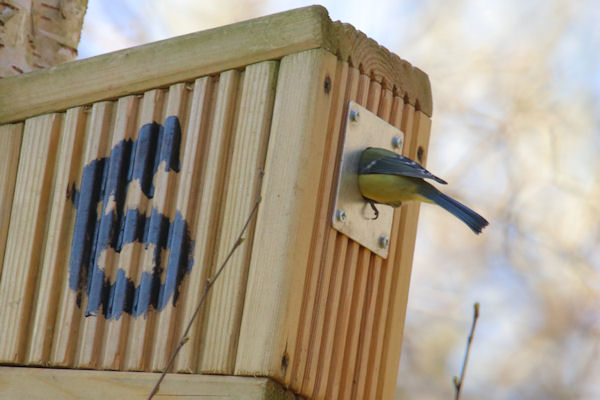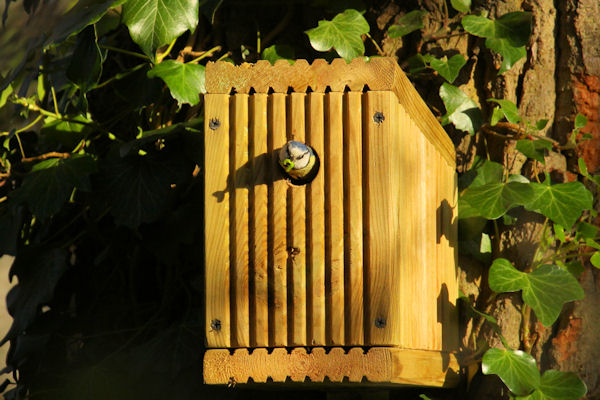Nest box update for 2022. Part 1.
In late September, a few bright days brought the opportunity to clean and repair the nest boxes in Bicknor Wood. Thank you to Linda who helped and identified the False Widow Spiders.
Day one, reported here, reached as far as box 18.
There are 28 visible boxes that are numbered and sponsored. If you sponsored a box this year, thank you very much for providing much needed habitat for the birds and income for the upkeep of the wood. There are a few more that are not easily visible from the paths. These are open-fronted boxes that are favoured by Robins and Wrens, but their easy accessibility makes them prone to predators, so they are tucked away in thickets and undergrowth.
Out of 36 boxes, 26 showed signs of nesting attempts. A very satisfying result of 72%.
Eurasian Copper Underwing
Some had obviously played host to wildlife apart from birds. Spiders, wasps, earwigs, slugs, moths, butterfly, woodlice, millipedes, centipedes and beetles were all seen in, on, or behind the boxes. We were surprised at what a productive sanctuary was provided by the small gap between box and tree trunk.
Some creatures will use the boxes to shelter as the weather becomes less clement. Whilst cleaning the boxes, we tried as much as we could not to evict any creatures that may rely on the shelter of the box to survive through the winter.
Giant House Spider
We already knew that birds had successfully bred from some boxes, but we didn't get the whole story until the boxes were taken down for cleaning. Sadly, some chicks didn't make it and a few feathery bodies were found. Another nest still contained 4 eggs which may have been sterile, or abandoned. But on the whole the birds are finding the boxes to their liking and young birds seen in the wood are testament to their breeding success. We can all be very proud.
Box 1 Blue Tit nest. Successfully fledged on May 21st
Box 2 No nesting attempt, but spiders and slugs were in residence. Repositioned for next season.
Box 2A Robin nest. A robin's nest is cup-shaped and usually only reaches to the lip of the open-fronted box.
Box 3 Great Tit nest. Fledging assumed. Also moths, spiders and a butterfly chrysalis. Fledging uncertain, but assumed.
Box 3A Robin nest. It is feasible that the same birds nested in 2 different boxes. Robins frequently have 2 or 3 broods a year. Some birds may re-use a successful nest, others may build new ones.
Box 4 Blue Tit nest. Fledging assumed. Plus earwigs, woodlice and millipedes. White-legged Snake Millipede, Eurasian Copper Underwing.
Box 6 Blue Tit nest. Fledged on May 16th
Box 7 Blue Tit nest. Remains of 3 chicks found in the nest. Blue Tits typically lay between 8 and 12 eggs. Exceptionally a pair might lay 15. Some fatalities are to be expected in such big clutch sizes.
Box 8 Nesting attempt, probably not successful. Nest very sparse with no lining. Woodpecker damage. This pair may have abandoned their first attempt in this box and succeeded elsewhere. The damaged box has been replaced.
Box 9 Blue Tit nest. Fledged on May 27th. Remains of one chick found in nest. Damaged box replaced. Eurasian Copper Underwing, Wax moth.
Box 9A Robin nest.
Box 10 No nesting attempt, but spiders and spiders' egg sacs in box and behind box.
Box 11 Blue Tit nest. Fledging assumed. Remains of one chick found in nest.
Box 12 Blue Tit nest. Fledged on May 30th. Remains of one chick found in nest.
Box 13 Blue Tit nest. Fledged on May 24th
Box 14 No nesting attempt.
Box 15 Blue Tit nest. Fledged on May 18th.
Box 15A Robin nest.
Box 16 Nesting attempt. Sparse nest with no lining. Attempt abandoned for unknown reason.
Box 17 Blue Tit nest. Fledged on May 30th. Four unhatched eggs found in the nest. With large clutch sizes it is not unusual to have unfertilised eggs. this pair was seen bringing food into the nest, so it is reasonable to assume that the remainder of their eggs hatched. False Widow Spider
Box 18 No nesting attempt. Repositioned as it's current siting was overgrown.
Other birds observed building nests and/or feeding young in the wood include Great Spotted Woodpecker, Blackbird, Dunnock, Chiffchaff, Magpie, Woodpigeon, Collared Dove and Mistle Thrush.
Birds that have exhibited behaviour consistent with breeding attempts are Song Thrush and Blackcap.
14 species of bird may have bred in the wood this year. Unfortunately the Nuthatch and Treecreeper were seen very infrequently this season and did not show any signs of breeding when they were noted.















Comments
Post a Comment